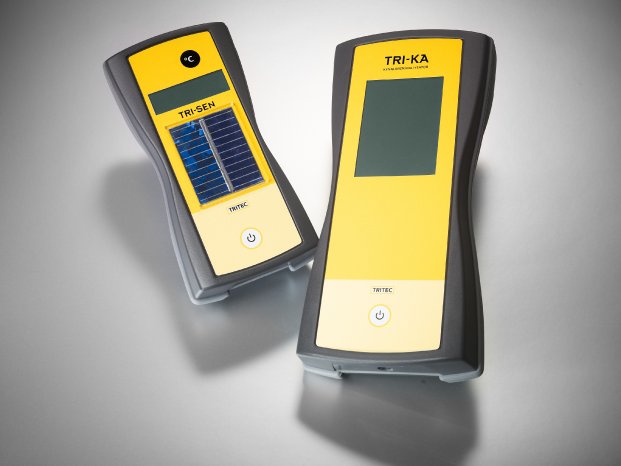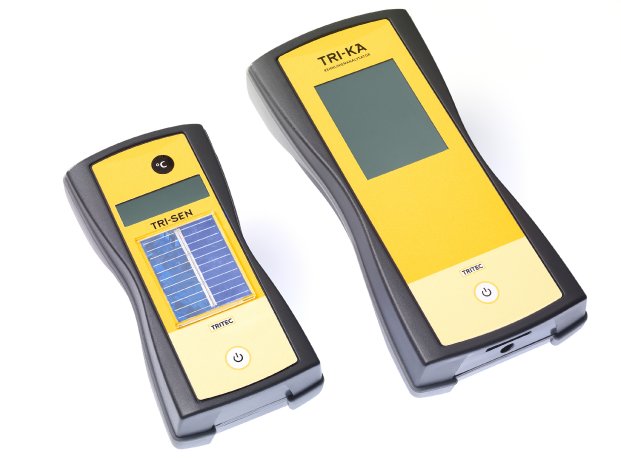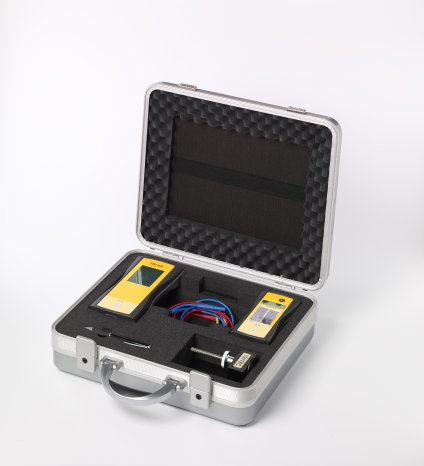The Swiss photovoltaics distributor and system integrator TRITEC has developed the new characteristic curve measuring device TRI-KA II that is perfectly tailored to today’s and future needs of PV installers. Using the characteristic curve analysis, the PV system’s output can be measured during installation, hand-over or maintenance of the system and compared with the nominal output. Work with the characteristic curve measuring device TRI-KA could not be more efficient: The device handles very easily and its use is extremely flexible and variable due to its technical advancements.
In addition, the measuring procedure of the TRI-KA, combined with the TRI-SEN, is extremely simple. The radio link between the irradiation and temperature sensor TRI-SEN on the roof and the analytical device TRI-KA at the inverters in the basement allows for an uncomplicated wireless measurement of the off-load voltage and the short-circuit current of the system. Thanks to the increased input range for current (0.1 to 15 A) and voltage (1 to 1000 V), both individual modules and entire strings can be measured. The TRI-SEN now has two reference cells (mono- and poly-crystalline), and thus the sensor provides more precise irradiation values and the results are even more conclusive.
The TRI-KA is supplied as a full set in a high-quality case, which contains everything needed for characteristic curve analyses. Due to its easily manageable size, low weight and sturdy casing, the TRI-KA is perfectly suited to be used on the roof and in the field.
Also new is the operation of the TRI-KA via a touch screen with enhanced menu navigation. Furthermore, the software for the analysis of the readings has been completely revised and designed even more user-friendly in collaboration with installers. The software can be navigated intuitively and without much prior knowledge. It guides the user through the analysis step by step. The programme is downwards compatible so that older measurements can still be read.
Using the TRI-KA to analyse the characteristic curve opens up totally new ways to prove quality and reliability:
- An innovation is the possibility of acceptance protocols during hand-over of the system to the client
- With a few clicks the output of a system can be monitored over several years
- Errors and defects of the system can easily be identified
The end users will feel the benefit of the characteristic curve analysis mainly in terms of money: A system installed and maintained in the best possible way will ensure that they achieve maximum yields.
Measuring Procedure
1. Surface temperature of modules can be measured without contact using the TRI-SEN
2. Install the TRI-SEN at the same level as the modules and measure the irradiation
3. Use the TRI-KA to measure the off-load voltage and short-circuit current of the system
4. Establish the current/voltage characteristic curve of the system with the TRI-KA
5. Wireless transfer of measurements from the TRI-SEN to the TRI-KA
6. Import results from the SD card of the TRI-KA to the PC and analyse them using the software
-----------------
Specification
Measuring values: I/U characteristic curve, UOC, ISC, UMPP, IMPP, PMPP, global irradiation, module temperature, TRI-SEN inclination
Calculated values: STC values (UOC, ISC, UMPP, IMPP), filling factor, MPP output
Measuring range
Input voltage: 1 - 1000 V
Current: 0.1 - 15 A
Irradiation (TRI-SEN): 100 - 1200 W/m2
Temperature (TRI-SEN): 0-100ºC
Measuring precision:
- Current: 0.1 A
- Voltage: 1.0 V
- Temperature: ±3 % (on black surface)
- Irradiation: ± 5 %
Measurement duration: 15 – 30s
Save slots for characteristic curve: Depending on size of the SD card
Device specifications TRI-KA
Display: Colour touch screen
Voltage supply: Lithium Polymer
Battery operating time: 6h
Protection class: Class II, CAT II 1000V, CAT III 600V, CE
Operating temperature: 0-50ºC
PC connection : SD(/SDHC) memory card
Mass (Length / Width / Height): 210 mm / 105 mm / 41 mm
Weight: 500 g
Device specifications TRI-SEN
Display: b/w LCD display
Voltage supply: Lithium Polymer
Battery operating time: 6h
Protection class: CE
Operating temperature: 0-70ºC
Reference cells: Mono and poly crystalline cell
Mass (Length / Width / Height): 160 mm / 82 mm / 41 mm
Weight: 200 g



